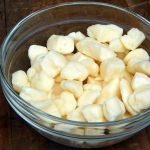Squeaky cheese curds are cooked cheddar-style cheese that hasn’t been fully pressed and aged. They are delicious as a snack, and are perfect as a melting cheese for pizza or poutine! (How can you tell that I’m Canadian?)

How to serve cheese curds
We love cheese curds. The curds you buy in the store are NOTHING like homemade curds. Fresh curds have a unique soft and squeaky texture. Then they firm up within a few hours.
Wondering what you can do with your curds?
- Snacks: They are easy to take along on picnics, walks, or when traveling.
- Poutine: This traditional Canadian dish features fries topped with cheese curds and gravy. It is unbelievably delicious.
- Chili cheese fries: I guess it’s a “healthier” version of poutine? Regardless, swapping chili for gravy certainly turns fries into a meal.
- Melting: Curds can be used as a melting cheese for pizza and other dishes.
- Salads: Fresh and delicious curds can be crumbled onto salads.
Learning to Make Cheese
Squeaky cheese curds are a good place to start for anyone wanting to experiment with making hard cheese. It involves all the same steps as cheddar, without the aging process. So you don’t need a proper cheese press, nor a place to age the cheese.
However, this isn’t a beginner-friendly recipe. The recipe assumes that you have basic knowledge of cheesemaking, the necessary ingredients, and how to sanitize. If it’s your first time making cheese, please read through the step-by-step guide to cheesemaking.
If you want to make a simple aged cheese, then try farmhouse cheese, which is a simplified version of cheddar.
PrintCheese Curds
Cheese curds are fresh cheddar cheese that isn’t pressed or aged. As a cooked curd cheese, they are perfect as a snacking cheese or for melting. See the section above for serving options.
- Prep Time: 45 minutes
- Cook Time: 1 hour
- Total Time: 1 hour 45 minutes
- Yield: 4 cups 1x
- Category: Cheese
- Method: Fermented
- Cuisine: Canadian
- Diet: Vegetarian
Ingredients
- 4 liters of milk
- 1/2 package of mesophilic culture (see notes)
- 1/4 tsp of liquid rennet in 2 Tbsp filtered water
- 1/4 tsp of calcium chloride in 2 Tbsp filtered water (if using pasteurized milk)
- 1 Tbsp salt (non-iodized)
Instructions
- Heat milk to 90F (32C). Stir in the culture and maintain the temperature for 90 minutes.
- Stir in calcium chloride, then the rennet, mixing thoroughly.
- Maintain the heat at 90F and let the milk rest for 45 min to set the curd.
- When the curds show a clean break, cut the curds into 1/2-inch cubes.
- Cook the curd by gently stirring every 5 minutes for the next 1/2 hour, while slowly raising the temperature to 110F (43C).
- Once you have reached 110 F, maintain the temperature and continue stirring every 5 minutes for another 30 minutes. The curds will have cooked for a total of 1 hour.
- Line a strainer with butter muslin and pour the curds and whey into it.
- Hang the curd in the butter muslin and allow it to drain for 30 minutes.
- Twist the muslin tight then press the cheese with 8 lbs of weight for 2-3 hours.
- At that point, the curds will have knit into one solid mass. Break them up with your fingers and sprinkle on the salt.
- The curds will be “squeaky” for the first few hours. Otherwise, you can store them in the refrigerator and use them within 4 weeks.
Notes
- The best milk for cheesemaking is non-homogenized. If you’re using homogenized milk then add the calcium chloride.
- You can replace the mesophilic culture with a 1/4 cup of milk kefir or a 1/4 cup of cultured buttermilk. The flavor will be slightly different, but it will acidify the milk. If using homemade culture you may want to test the acidity
of the cheese before setting the rennet.

What size package of culture do you have cause I have a huge one and don’t think putting.half of that will fly
I have only ever used individual packages or tablets. The package ought to say how much to use for 1 gallon (approx. 4 liters) of milk. If it doesn’t provide instructions, then try 1/16 of a tsp. Good luck!
do you mean 1 gallon is 16 cups of milk? I believe a quart is 4 cups and a gallon is 4 quarts.
Oops! A typo in the comment. I meant 1 gallon (4 Liters). 🙂
Would consider adding a Pinterest logo so that your recipes/blogs can be “pinned”??
Hum… I actually use a fairly expensive plug in that provides both a sidebar Pinterest icon as well as one on the actual photos. I just checked and it appears to be working on my computer. I wonder why it isn’t working on your computer? The floating sidebar is on the left, and the icon on the photos is in the top left corner. Cheers, Emillie
I have a question- are you able to use raw milk in the squeaky cheese curd recipe? If i’m reading things correctly, I DON”T have to add the mesophilic culture if i use raw milk? Or do i still need to add the culture? My parents are from Quebec, and we get cheese curds every time we visit. If i can make them here, that would be GREAT!!
Unfortunately, I don’t have access to raw milk, so I always add culture (or use milk kefir). However, my understanding is (based on a stack of cheesemaking books) that raw milk naturally contains mesophilic cultures. The trick is that the exact cultures in raw milk will change based on the seasons, what the cows are eating, etc. Since the cheese is also set with rennet, you can use the natural culture. The biggest difference will be in the flavor of the cheese. Enjoy!
I have been making cheese for a couple of weeks now. What really confuses me is how to measure the weight in the Press. I have tried finding it on you tube and Google and can’t find the answer
If you have a particular press that uses tension for the weight, then you will need to read the directions for your pressG to determine the various weights. Otherwise, the weights are actual physical weights. For example, pressing at 20 lbs. literally means 20 lbs. of weight. Cheers!
Hi!
You mention testing the pH when using a homemade culture, but what’s the target range to go for? I can’t find it anywhere =/
I’m so excited to try this recipe! Been wanting to try poutine for years but never had access to curds, so decided it’s time to make my own now 🙂
I don’t test for pH, as it’s not really necessary for home use. 🙂 However, you want the pH to be between 5.5 and 5.1. If you’re outside of that range your cheese won’t melt properly. Poutine is delicious. Good luck!
Thank you!
Homemade poutine! This is great!
I’m sorry you struggled. Curds are a bit more complicated. It depends on the quality of your milk, the culture, and rennet. Maintaining the right temperature for the right length of time. If you’re keen on making cheese, try something a bit easier like cream cheese or cottage cheese. Cheers!
I’ve made this recipe maybe close to 100 times over the past couple years and I’ll continue to make it as long as I continue cheesemaking. This is my number one go to curd recipe and I’ve tried tons till I found this. I keep my own goats and milk them and make these curds the most out of any other cheese. They even store well for months in the fridge as long as they are packed with food saver. I use 1/16 tsp mesophyllic culture instead of a 1/2 pack but this is because I use bulk culture and raw goats milk.
Ooh… I haven’t tried goat’s milk! Glad the recipe works for you! 🙂
Can you tell me how to flavor the cheese curds? I’d like to make them with a chive or garlic flavor. Thanks so much!
I always add flavor to my cheese when I add the salt. It’s really the best way to flavor cheese without impacting the quality of the curd. Cheers!
Thank you so much Emillie!